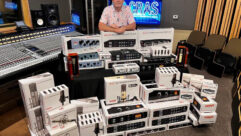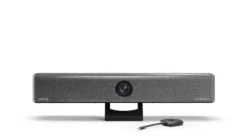Welcome To The Funhouse
HoloDek aims to be a one-stop shop for immersive AV in a town near you.
ALL WORK and no play makes for a dull business model. That’s the mantra at HoloDek, a Hampton, NH-based company that’s targeting both gamers and enterprises with an immersive AV system that would be installed in locations such as strip malls and movie theaters.
“Real estate owners question all the time: ‘We think you’ll do fine at night and on weekends with the gamers, but what are you going to do during the day?’” says Kit McKittrick, HoloDek’s CEO. “We’re going to be doing AV conferencing and events that allow ‘edutainment.’ For instance, we’ll donate our facilities to charities, which do unbelievable amounts of training. They can walk away with a burned CD of the whole training session.”
HoloDek currently is found only at the company’s test facility in Hampton. It’s open to the public, with rates ranging from $6/hour for gaming on a PC or Xbox to $40 for a 10-hour block. All or parts of the facility can be rented out for birthday parties, where attendees can play games, or events such as the Super Bowl, when suites are available. All of those services have one thing in common: They’re a way to experience large-screen games or video without shelling out for a high-end PC or home theater.
Like the commercial facilities that it will serve as a model for, the test site features a “half-pipe” — a curved screen that’s 20 feet wide and 12 feet high, producing an in-your-face effect. It also has a 20-foot dome, where one or more users get an immersive multimedia experience, à la a flight simulator.
Besides company-owned facilities in places such as strip malls, HoloDek’s buildout plans include movie theaters. Like new 3D digital cinema technologies, HoloDek could give exhibitors a way to lure people away from their big-screen TVs and Netflix and back to theaters — at least for gaming, if not for movies. Either way, it’s revenue.
Warped view
HoloDek’s system relies heavily on stock pro AV equipment, which currently includes DLP projectors from Hewlett-Packard. “We’re considering going to even higher-end projectors for our larger screens,” McKittrick says. “We have 20-foot screens that are basically run by three projectors and by three different connected PCs. We’re using those in the 180-degree half-pipe, and we’ve used as many as 13 projectors in our spheres.”
But HoloDek also has proprietary software to tie together the stock gear. “That connects and runs each individual view,” McKittrick says. “So in gaming, once you get a coordinate system that defines where the starting point is, you then concurrently run the software for 13 PCs and 13 projectors.”
Projecting images inside a dome isn’t a new idea. One recent example is Tokyo’s CyberDome, where 3D images are splashed on a 30-foot-high curved dome using an array of 18 SXGA projectors from JVC. (For photos of CyberDome, see http://www.vrsj.org/ic-at/ICAT2003/tectour.html.) The heart of that system is technology called eWarp, which maintains a high-quality image as it corrects for curved surfaces. Developed by San Jose-based Silicon Optix, eWarp applies high-quality scaling to certain regions of the screen. For example, a lens with pincushion distortion stretches images out toward the corners, so eWarp corrects by scaling the image slightly downward toward the corners and upward near the center. Because eWarp is software, it could be built into projectors or scalers.
Although CyberDome and HoloDek are significantly different in terms of underlying technology and target markets, they’re similar in the sense that they aim to make AV more immersive. The appeal for gamers is hard to miss, but enterprises and individuals could justify trips to HoloDek if the simulator experience reduces the amount of expensive hands-on training later on. One example is using Microsoft’s “Flight Simulator” inside of HoloDek’s half-pipe. “Some flight schools say that the latest ‘Flight Sim’ is as good as flying the real thing,” McKittrick says.
Who needs it?
HoloDek’s roots are in robotics. The company’s vice president for technology, Mike Fortier, also is president of Hexel, which makes “hexapod” equipment for applications such as assembly line systems that install light bulbs in cars.
HoloDek is leveraging that hexapod expertise in AV by offering a “Rotopod,” where a person is harnessed into a chair that can be rotated 360 degrees inside a dome to simulate, for example, the cockpit of a prototype plane or the Millennium Falcon. “You can see 360 degrees and move anywhere in that space that you want to view,” McKittrick says.
That moving environment could be a good fit for a variety of applications. One possibility is industrial design, where HoloDek could leverage its relationships with companies such as automakers to help sell into that space. Another potential market is home building, where the cost of a HoloDek visit or an onsite installation could be justified by the ability to show a buyer what a room would look like in a variety of wall finishes or lighting arrangements. “We have some architects who want to walk their clients through a 360-degree animation,” McKittrick says. “You could demonstrate literally every room in a home.”
As part of its effort to court the enterprise market, HoloDek is pursuing certification from the International Association of Conference Centers (IACC), which sets and enforces standards such as ambient lighting, seat design, and available telecom services. Certification should give the company’s offering more credibility in the eyes of event planners, but considering the increasingly sophisticated AV setups in many meeting facilities, HoloDek needs more than just IACC certification to compete with hotels and convention centers. The Rotopod is one obvious differentiator, but HoloDek also plans to play up an endless assortment of tools, such as Tablet PCs, for meetings that center around drawing and note-taking.
“We can provide a meeting planner with everything that they could get in a hotel conference room, plus every participant will have their own high-speed computer, their own 6- to 8-foot screen, and almost any accessory that you could want,” McKittrick says.
Those types of market differentiators are key not only for helping HoloDek carve out a niche, but for attracting investment, too. The company currently is lining up financing to support a five-year buildout of 60 large facilities, each about 35,000 square feet and featuring a sphere, multiple half-pipes, and a few hundred gaming stations. The initial facilities would be in the Northeast —starting with Tyson’s Corner, VA — the region where it’s easier for the New Hampshire-based company to keep an eye on things during the expansion’s first stages.
The rollout also would include 100 smaller venues that would be built in mid-size markets. The latter could be fertile ground if HoloDek picks small cities that currently are underserved in terms of meeting facilities, yet have companies that could benefit from services such as immersive conferencing or distance learning. One hypothetical example is the branch office of a company that needs immersive, interactive conferencing across all sites but can’t justify the cost of building those facilities in all remote offices.
HoloDek also is looking to pick up revenue from research services such as focus group testing of prototype games, including assistance with analyzing that feedback in order to refine the games and develop market strategies. For gaming companies, potential benefits include being able to test games in a wider variety of markets rather than sending them to testers, who might leak the game or its source code. The tests also would bring more gamers into HoloDek facilities, increasing the chances that they’ll come back on their own once a test is done. And although HoloDek has picked up a lot of mainstream press for its gaming offerings, the research services also could be applied to consumer and enterprise software, helping introduce the company’s facilities to those demographics, too.
Rent or buy?
Although HoloDek is gearing up to build facilities that it would own and operate, the company also is willing to build them for customers. One possibility is a HoloDek facility on the campus of an automaker that wants to use the setup for industrial design. McKittrick also sees HoloDek potentially trickling down to high-end home installations, such as personal gaming theaters.
The cost of a HoloDek installation varies significantly, based on factors such as the resolution of the projectors, the facility’s size, and whether it includes the Rotopod. “If you took the robot out of the equation, you’re looking at from the low thousands to $50,000 to $100,000,” McKittrick says.
A HoloDek installation with a dome can run as small as a radius of 4 feet. The size is determined partly by the customer’s budget and partly how many people would use it simultaneously. “Some companies that have contacted us want to put a hundred people inside the dome,” McKittrick says. “I’m seeing a sweet spot in the 10- to 12-foot area.”
Tim Kridel is a freelance writer and analyst who covers telecom and technology. He’s based in Kansas City and can be reached at[email protected].










